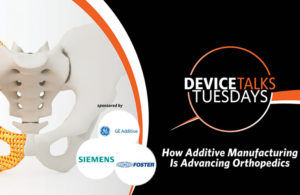Orthopedic device giant Stryker uses additive manufacturing to make porous geometries that wouldn’t otherwise be possible
 3D printing, also called additive manufacturing, provides the ability to create new products and designs that are incredibly complex and hard to machine. For 20 years, Stryker has been on a journey to use additive manufacturing specifically to produce complex orthopedic implants. As a result, the company has made great strides when it comes to the way that orthopedic implants are designed and produced.
3D printing, also called additive manufacturing, provides the ability to create new products and designs that are incredibly complex and hard to machine. For 20 years, Stryker has been on a journey to use additive manufacturing specifically to produce complex orthopedic implants. As a result, the company has made great strides when it comes to the way that orthopedic implants are designed and produced.
On a recent episode of our DeviceTalks Tuesdays webinar — sponsored by GE Additive, Foster, and Siemens — Stryker executive Naomi Murray detailed the company’s two-decade additive manufacturing journey. Murray, the company’s director of advanced operations for additive technology, described how innovations utilizing 3D printing make healthcare better.
Here are four takeaways on how additive manufacturing is advancing orthopedics:
1. 3D printing enables game-changing innovation
For Stryker, there were two main drivers behind pursuing additive manufacturing: design freedom and rapid concept development.
Design freedom makes it possible to create new products and designs that have complex, hard-to-machine geometries — including hybrid structures and implants with functionally located porosity. “It [employing 3D printing] was really freeing in that we could make new geometries that we couldn’t otherwise make,” Murray said.
Additive manufacturing also enables rapid concept development where it’s possible to quickly develop and iterate prototypes and implants. Murray observed that one of the benefits of additive manufacturing as both manufacturing technology and prototyping technology is using the same material properties and tolerances when testing as in final manufacturing. The result is that data gathered during testing is the same as the data and performance expected during actual manufacturing.
2. Much of Stryker’s focus in using additive manufacturing for orthopedics has been on porous design
Porous implants are important in orthopedics because they help promote biologic fixation, which gives as much space as possible for the bone to interdigitate. However, historically it has been challenging to manufacture porous implant designs using traditional methods. In working on porous structures for more than 15 years and then using the power of additive manufacturing, Stryker has become a world leader in metal 3D printing of porous implants. Murray was delighted to share a photo that showed bone growth through a porous structure produced using additive manufacturing.
One crucial decision by Stryker, explained Murray, was maintaining complete control of the 3D printing technology, including strict and extreme control of the porosity structure. “Additive manufacturing allows that control for us to be able to use the technology to give us the features that we need,” Murray said.
3. SOMA is pushing the boundaries of ortho implant design
SOMA—Stryker Orthopaedics Modeling & Analytics—provides an evidence-based design approach. The foundation for SOMA is a comprehensive database of CT scans of bones, referred to by Murray as “the bone database.”
The database and software tools customized specifically for Stryker provide data for modeling and designing custom implants. The software suite, as part of SOMA, facilitates measuring, fitting and optimizing implants. Murray commented that these tools transform the design process. In conjunction with the designs created through SOMA, Stryker uses additive manufacturing to “deliver industry-leading implants fit to our customers,” according to Murray.
4. Multiple tools used in combination will create what’s next
In the future, Murray envisions the use of multiple tools in concert. Specifically, she sees the SOMA database used in conjunction with 3D printing and robotic surgery tools that enable surgeons to plan and place implants more accurately.
According to Murray, “When you put [these tools] together—revolutionizing design . . . and then a procedural innovation . . . it makes an exciting future for additive manufacturing in the orthopedic space.”
5. Additive manufacturing has sustainability advantages — but more progress is needed
Murray is of the view that sustainability is part of the additive manufacturing story. Already, 3D printing is more sustainable than some other technologies. Still, Murray sees it as a corporate and industry responsibility to ensure that additive manufacturing becomes even more sustainable. Therefore, she challenged the industry to look at ways to minimize post-processing from 3D printing.
Provided to Medical Design & Outsourcing by BullsEye Resources.